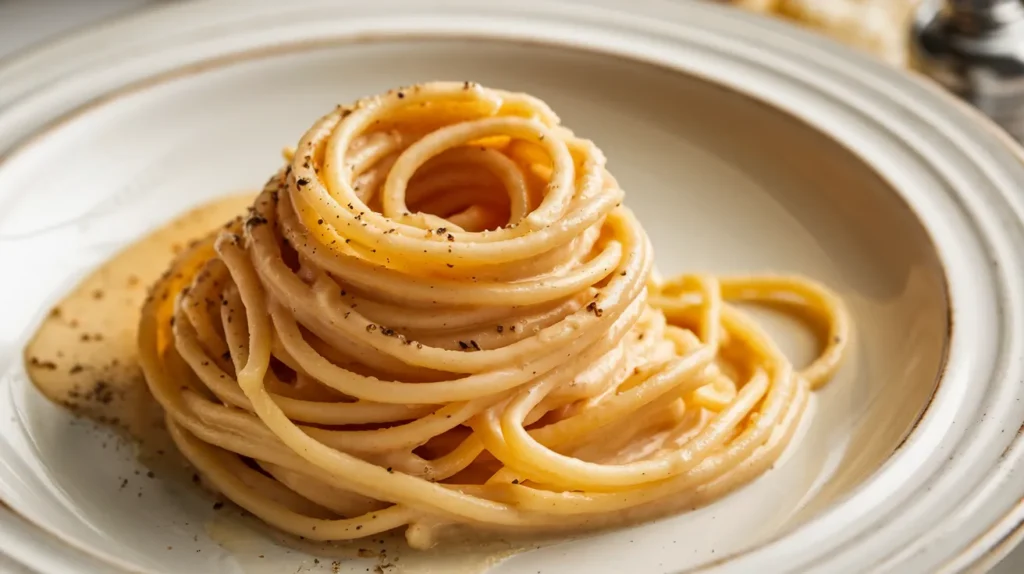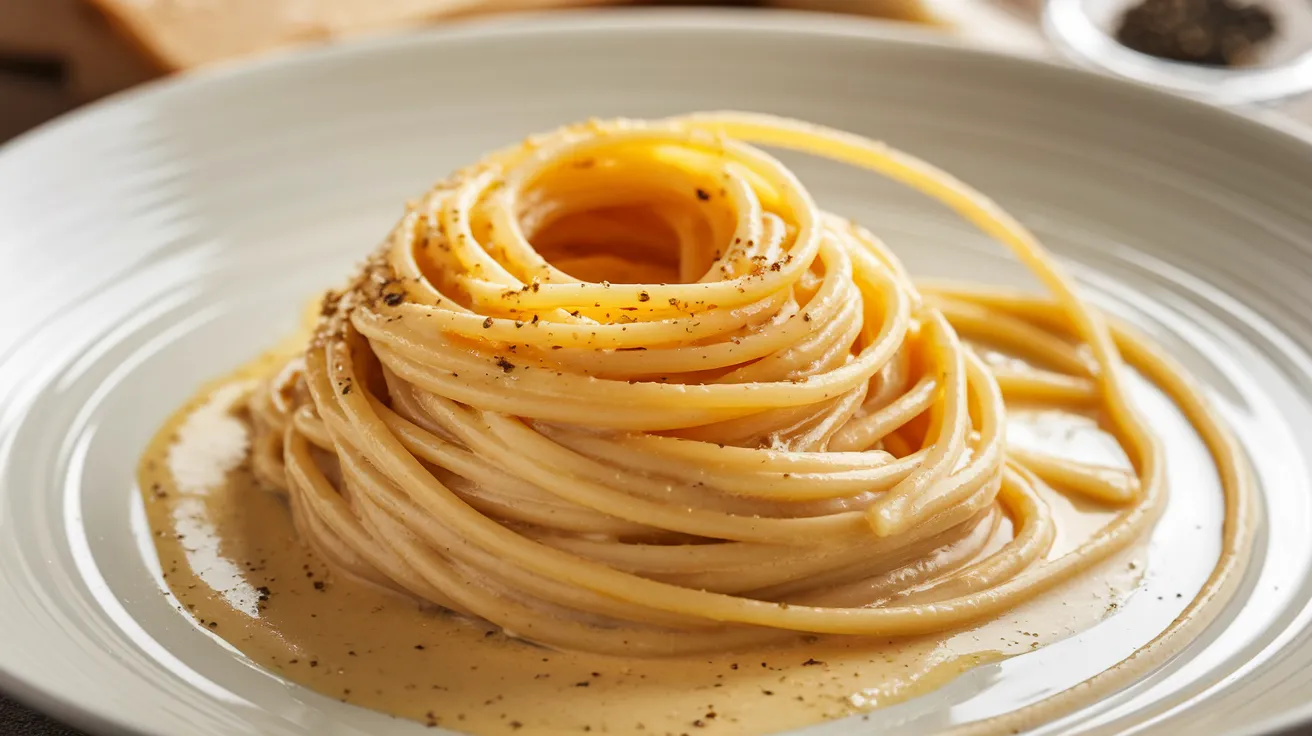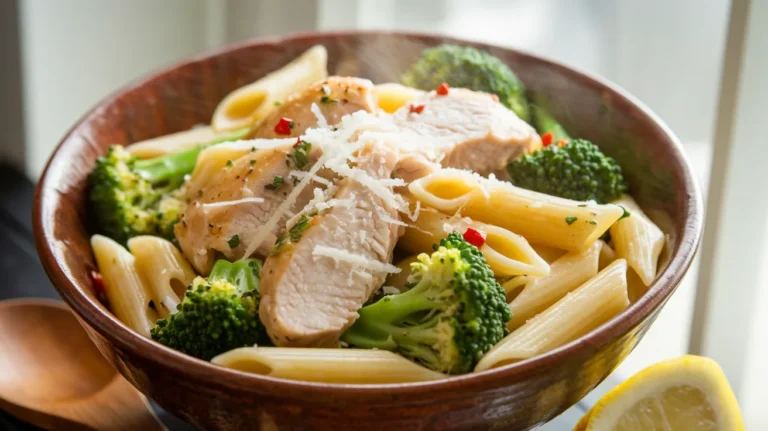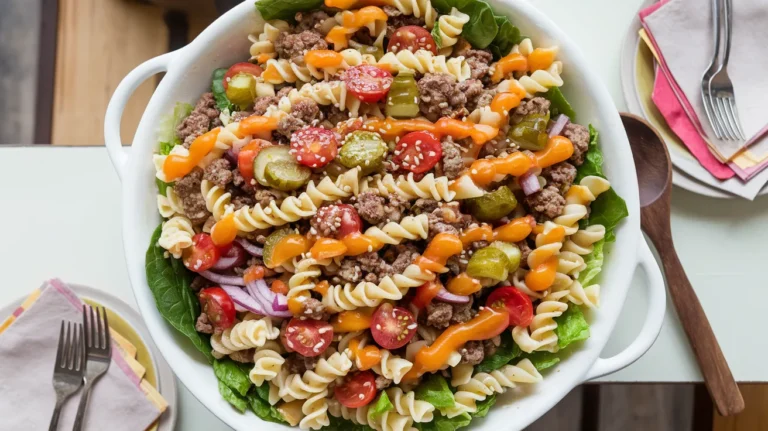Key Takeaways:
- Perfect the pasta water-to-cheese ratio for silky Cacio E Pepe sauce without clumping
- Choose authentic Pecorino Romano for traditional flavor intensity
- Master the crucial pasta tossing technique that creates the creamiest texture
- Learn why fresh-cracked black pepper makes a dramatic difference in this simple dish
Why Your Homemade Cacio E Pepe Keeps Failing (And How to Fix It)
You’ve tried making Cacio E Pepe before, but ended up with clumpy cheese or dry pasta instead of that silky, peppery sauce that made you fall in love with this dish at your favorite Italian restaurant.
This authentic Cacio E Pepe recipe solves those common problems with precise measurements and beginner-friendly techniques that guarantee success. While you might think this classic Roman pasta is complicated, it actually only requires four ingredients to create restaurant-quality results. If you enjoy this classic, you might also want to try my spicy variation with garlic and chili for a flavor twist!
Nutrition Facts
| Nutrient | Amount per Serving |
|---|---|
| Calories | 420 |
| Protein | 16g |
| Carbohydrates | 48g |
| Fat | 18g |
| Saturated Fat | 10g |
| Sodium | 520mg |
| Fiber | 2g |
Serving size: 1/4 of recipe (approximately 3oz dry pasta)
Prep Time & Cook Time
Prep Time: 5 minutes
Cook Time: 15 minutes
Total Time: 20 minutes
Servings: 4 persons
What You’ll Need for Perfect Cacio E Pepe
Ingredients List
| Ingredient | Amount | Notes |
|---|---|---|
| Spaghetti or Tonnarelli pasta | 12 ounces (340g) | Traditional choice |
| Pecorino Romano cheese | 1 1/2 cups (150g) | Freshly grated |
| Black pepper | 1 1/2 tablespoons | Freshly cracked |
| Salt | 1 tablespoon | For pasta water |
| Reserved pasta water | 1 cup | You’ll use about 3/4 cup |
Equipment List
| Tool | Purpose |
|---|---|
| Large pot | For cooking pasta |
| Large skillet | At least 12 inches for tossing pasta |
| Cheese grater | Fine grating for Pecorino |
| Tongs | For transferring pasta |
| Pepper grinder | For fresh-cracked pepper |
| Wooden spoon | For stirring |
| Measuring cups | For precise pasta water amounts |
| Timer | To ensure perfect pasta doneness |
Ingredient Substitutions
- Cheese Options: While traditional Cacio E Pepe uses only Pecorino Romano, you can substitute half with Parmigiano-Reggiano for a milder flavor.
- Pasta Choices: Bucatini or linguine work well if you can’t find spaghetti or tonnarelli. For something completely different, try my Bucatini Amatriciana recipe which uses similar techniques.
- Dietary Note: This dish contains dairy and gluten. For gluten-free options, use gluten-free spaghetti but be aware the texture will differ slightly.
Extremely Detailed Step-by-Step Instructions for Beginners
Preparation Phase
- Prepare your workspace
- Clear your countertop to have enough space for all ingredients and equipment
- Place your large skillet on the stovetop but don’t turn on the heat yet
- Set out all ingredients so they’re within easy reach
- Tip: Having everything ready before you start cooking prevents mistakes
- Grate the cheese properly
- Remove 150g (about 5-6 ounces) of Pecorino Romano from the refrigerator 30 minutes before starting
- Why? Room temperature cheese melts more smoothly and prevents clumping
- Use the finest side of your cheese grater (the side with the smallest holes)
- Hold the cheese firmly and grate using downward strokes over a clean bowl
- Continue until you have 1 1/2 cups of finely grated cheese
- Beginner’s warning: Pre-grated cheese contains anti-caking agents that will ruin the sauce’s texture
- Set aside in a bowl at room temperature
- Prepare the pepper correctly
- Place your pepper grinder over a small bowl
- Adjust the grinder to a medium-coarse setting (you want visible flecks of pepper, not powder)
- Grind until you have collected 1 1/2 tablespoons of fresh pepper
- Visual cue: This should be about a small mound in your palm
- Tip: Smell the pepper – it should be aromatic and fragrant. If it doesn’t have much scent, it may be too old
Cooking Phase
- Measure and heat water precisely
- Choose a pot large enough to hold at least 4 quarts of water with room for pasta
- Add exactly 3 quarts (12 cups) of cold water to the pot
- Note: This is less water than you might normally use for pasta, which is intentional for creating starchy water
- Place pot on stove and turn heat to high
- Cover with lid to speed up boiling
- Salt the water correctly
- Once water reaches a full boil (large bubbles breaking at surface), remove lid
- Add exactly 1 tablespoon of salt to the water
- Important: This is less salt than typical pasta cooking because Pecorino is already quite salty
- Stir once to dissolve salt
- Visual check: Water should taste salty but not as salty as seawater
- Cook the pasta properly
- Add 12 ounces of pasta to the boiling water
- Set your timer for 2 minutes LESS than package instructions for al dente
- Example: If package says 9 minutes for al dente, set timer for 7 minutes
- Stir immediately after adding pasta and then again after 30 seconds to prevent sticking
- Stir occasionally during cooking
- How to check: At the end of cooking time, remove one strand and bite it – you should feel a firm resistance and see a tiny white dot in the center
- Toast the pepper (while pasta cooks)
- About 3 minutes before pasta is done, place your large skillet on a different burner
- Turn heat to medium (not high, or pepper will burn)
- Add 1 tablespoon of your ground black pepper to the dry skillet
- Using a wooden spoon, move the pepper around constantly for 30-45 seconds
- Visual cue: Pepper should become fragrant but not smoking
- Warning sign: If you see any smoke, immediately remove from heat
- Why do this? Toasting releases the pepper’s essential oils for maximum flavor
- Reserve pasta water properly
- Place a heat-safe measuring cup next to your pasta pot
- 30 seconds before pasta reaches your timer setting, carefully dip the measuring cup into the pot
- Scoop out at least 1 cup of the starchy pasta water
- Safety tip: Use an oven mitt if needed, as the water is extremely hot
- Place reserved water within easy reach of your skillet
Assembly Phase (The Most Critical Steps)
- Create the base sauce (work quickly from this point)
- Make sure your skillet with toasted pepper is still on medium heat
- Carefully pour 1/4 cup of the reserved pasta water into the skillet with the pepper
- Caution: It will sizzle and steam; keep your face away
- Stir immediately with wooden spoon to combine
- Reduce heat to medium-low
- Let the pepper-water mixture simmer for 20-30 seconds
- Visual cue: You should see small bubbles, not a rolling boil
- Transfer pasta at exactly the right time
- Check that your pasta is 2 minutes shy of package al dente time
- Using tongs, grab a portion of pasta directly from the water
- Let excess water drip off for 2 seconds
- Transfer pasta directly to the skillet with pepper-water mixture
- Repeat until all pasta is transferred
- Important: Do NOT drain pasta in a colander
- Why? The starchy coating on the pasta is essential for the Cacio E Pepe sauce
- Begin the critical tossing technique
- Keep heat on medium-low
- Using tongs, lift and turn pasta continuously for 30 seconds to coat with pepper water
- Technique tip: Use a lifting and folding motion rather than stirring
- The pasta should start to absorb the water and look glossy
- Add cheese in stages (first addition)
- Turn the heat OFF completely
- Critical step: Wait 5-10 seconds for the skillet to stop sizzling
- Add exactly 1/3 of your grated Pecorino (about 1/2 cup)
- Immediately begin tossing with tongs using a lifting and folding motion
- Visual cue: Cheese should begin to melt and coat pasta strands
- Problem sign: If cheese immediately clumps, your pasta was too hot – next time wait a few seconds longer
- Continue building the sauce (second addition)
- Once first addition of cheese is mostly melted (15-20 seconds of tossing)
- Add another 1/3 of your grated cheese
- Immediately add 1/4 cup more of the reserved pasta water
- Resume tossing vigorously for 30 seconds
- Arm workout alert: This continuous motion is essential for a smooth sauce
- Visual progress: Sauce should be becoming creamy but still quite loose
- Complete the sauce (final addition)
- Add the final 1/3 of your cheese
- Continue tossing for 45-60 seconds
- Assessment: Sauce should now be coating the pasta but still flowing
- If sauce seems too dry, add pasta water 1 tablespoon at a time
- If sauce seems too wet, continue tossing for another minute
- Perfect consistency check: When you lift pasta with tongs, it should look glossy and the sauce should coat the strands without pooling too much in the pan
- Temperature tip: The pasta should be hot enough to hear a slight sizzle if you stop tossing for a moment
- Final adjustments
- Take a quick taste test
- If needed, add a pinch more pepper
- Resist adding salt as the Pecorino is usually salty enough
- For extra creaminess, add 1-2 more tablespoons of pasta water and toss again
- Texture note: Sauce will continue to thicken as it cools, so err on the slightly loose side
Serving Phase
- Plate immediately and properly
- Pre-warm four dinner plates in a 200°F oven or with hot water (then dried)
- Using tongs, grab a quarter of the pasta
- Lift it high above the plate (6-8 inches)
- Lower onto the center of plate while twisting your wrist to create a neat spiral mound
- Repeat for all four plates
- Speed is crucial: The entire plating process should take less than 60 seconds
- Finish with finesse
- Grind a small amount of additional fresh black pepper over each plate
- If desired, grate a small amount of extra Pecorino on top
- Serve immediately
- Eating tip: The ideal temperature for enjoying Cacio E Pepe is very hot, but not burning

Troubleshooting Common Issues
Problem: Clumpy Cheese
- Solution: Make sure pasta is hot but heat is OFF before adding cheese
- Always add cheese gradually, not all at once
- Toss continuously while adding cheese
- Recovery tip: If cheese clumps, add 2 tablespoons hot pasta water and toss vigorously
Problem: Watery Sauce
- Solution: Let the pasta finish cooking in the skillet to absorb extra moisture
- Continue tossing until sauce thickens and clings to pasta
- Remember the sauce will thicken more upon standing
- Quick fix: If sauce remains too watery, add a bit more cheese and toss well
Problem: Dry or Sticky Pasta
- Solution: Add pasta water 1 tablespoon at a time until silky
- Don’t let the finished dish sit too long before serving
- If it dries while plating, add a final splash of pasta water
- Prevention: Keep some pasta water warm in case you need it for adjustments
Variations & Serving Ideas
Classic Add-Ins
- Add 1/2 teaspoon of red pepper flakes for heat
- Garnish with chopped fresh parsley for color
- Drizzle with high-quality olive oil just before serving
Protein Options
- Top with a poached egg for richness
- Add 4 ounces of pancetta, crisped and drained (though purists may object)
- Serve alongside simply grilled chicken for a complete meal
Pasta Shape Variations
While traditional Cacio E Pepe uses long pasta shapes, you can experiment with other pasta types for fun variations. If you’re looking for something completely different, try my butterfly pasta (farfalle) recipe which works beautifully with similar cheese-based sauces.
Storage & Reheating Instructions
Storage
- Cacio E Pepe is best enjoyed fresh
- If you must store leftovers, refrigerate in an airtight container for up to 2 days
- The texture will change as the cheese solidifies
- Storage tip: Keep any remaining pasta water in a separate container for reheating
Reheating
- Place leftover pasta in a non-stick skillet
- Add 2-3 tablespoons of water (ideally reserved pasta water)
- Cover with a lid and heat over medium-low heat
- After 1 minute, remove lid and gently stir
- Continue heating until pasta reaches 165°F
- Warning: Microwave reheating will make the cheese tough and rubbery
- Texture note: Reheated Cacio E Pepe will never be as creamy as fresh, but can still be tasty
Safety Notes & Final Tips
Food Safety
- Use freshly grated cheese, not pre-grated (which contains anti-caking agents)
- Refrigerate any leftovers within 2 hours of cooking
- Ensure pasta reaches 165°F when reheated
Pro Tips
- The key to perfect Cacio E Pepe is speed and constant motion when adding cheese
- This dish relies on technique over ingredients – practice makes perfect
- Remember that the pasta water is the secret ingredient that brings everything together
- Confidence builder: Even if your first attempt isn’t perfect, you’ll learn the feel of the sauce with practice




